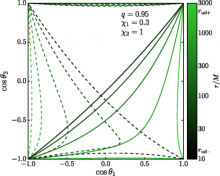
Abstract
Binary black holes on quasicircular orbits with spins aligned with their orbital angular momentum have been testbeds for analytic and numerical relativity for decades, not least because symmetry ensures that such configurations are solutions to the spin-precession equations. In this work, we show that these solutions can be unstable when the spin of the higher-mass black hole is aligned with the orbital angular momentum and the spin of the lower-mass black hole is anti-aligned. Spins in these configurations are unstable to precession to large misalignment when the binary separation is between two values that depend on the masses and spin magnitudes of the two binary components. This instability exists for a wide range of spin magnitudes and mass ratios and can occur in the strong-field regime near merger. We describe the origin and nature of the instability using recently developed analytical techniques to characterize fully generic spin precession. This instability provides a channel to circumvent astrophysical spin alignment at large binary separations, allowing significant spin precession prior to merger affecting both gravitational-wave and electromagnetic signatures of stellar-mass and supermassive binary black holes.